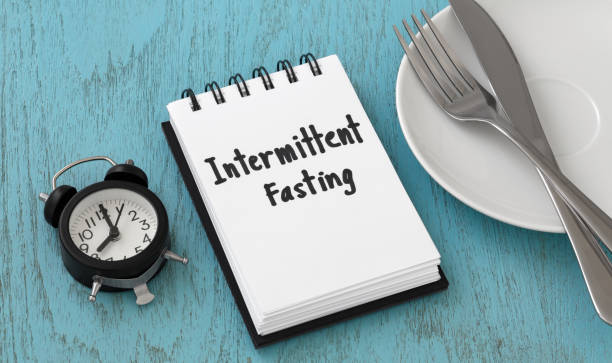Intermittent fasting is a simple way to start burning fat quickly ?
Today, many individuals are interested in intermittent fasting, but few understand how it functions. There have been claims that intermittent fasting (IF) speeds up fat loss and aids in rapid weight loss. So, how does IF actually function? How does your body respond to intermittent fasting?
How much weight loss should you expect from an
intermittent fasting diet? What about the combination of this diet and
exercise? Does it even work? Okay, then, let's find out!
What does Intermittent
fasting entails?
One method of dieting known as "Intermittent Fasting" involves eating only during set time intervals. The 16:8
intermittent fasting (IF) diet is a common type of IF diet in which food intake is
restricted to an 8-hour window each day.
In addition to helping you lose weight and burn
fat, intermittent fasting may also improve your health and mental acuity.
Diabetes, epilepsy, Alzheimer's, autism, Parkinson's, and other neurological
disorders may all benefit from it. A study showed that after six months, persons who practice
intermittent fasting lose about 6% of their body fat, which is 10 times more
than the fat loss experienced by people on a diet who don't fast. In this
study, individuals were allowed to eat breakfast at 8:00 AM one day and again
at the same time the next day, so long as they went at least 18 hours without
eating. That's right; they'd go all day without eating. Additional studies demonstrate
that fasting causes a buildup of fat molecules in our cells, which hinders our
ability to burn fat.
After fasting for 18 hours, adipose tissue starts
metabolizing its own fat molecules. This is why fasting has been shown to
reduce body fat and reduce hunger levels.
What Happens to Your Body When you Fast ?
Once the body enters ketosis during intermittent
fasting, fat is used for energy. When fat cells are metabolized, they release
fatty acids and glycerol, which the body can then use for energy. Ketones are
also produced and released into the bloodstream as a result. When insulin is
not present, the body produces ketones.
The goal of intermittent fasting is, therefore, to
lower overall calorie consumption and induce ketosis in the body. The process
consists of three elementary steps:
First
phase or Fed Stage
A phenomenon known as the gastrocolic reflex occurs
in the body during the initial hours of fasting. What happens after you have taken food is
called digestion, and it's the process through which your body breaks down the
food into usable nutrients.
An increase
in insulin production follows meal consumption. In reaction to high blood sugar
levels, the pancreas secretes the hormone insulin. It aids in the delivery of
glucose to the body's fat and muscle cells.
Consuming large amounts of carbohydrates might
raise your glycogen and blood sugar levels. These surplus sugars serve as a key
energy source, being stored in the liver and skeletal muscles. As a bonus, it
also boosts hormones like leptin, which acts as an appetite suppressant. In the
middle of a fast, breaking it with food returns you to your fed state.
After your body has finished breaking down your meal, your
body's glycogen stores will begin to deplete. In the absence of any remaining
glycogen, the liver begins to break down fat stores into byproducts called
ketones. Fat loss will occur after you reach this point.
Fasting for 12-14 hours and then eating a
low-carbohydrate diet may help you enter a fat-burning phase more quickly than
eating carbohydrates regularly. The third phase of entering ketosis is required
for those on a high-carb diet.
Third
Phase, or Prolonged Fasting
People who eat a lot of carbohydrates may find it
difficult to achieve the fat-burning state of ketosis. You will need to fast
for a very long time if you fall into this category.
There are many positive effects of fasting for
16-20 hours, including the reduction of glucose levels, the beginning of
ketosis, and an increased metabolic rate.
When does fat-burning actually begin in the human body?
Each of these stages takes the body around 12 hours to complete. The time
it takes to do this task may vary from person to person depending on a number
of factors. In any case, 12 hours is the typical time frame.
👉Receive more than 50% discount on fat burners and weight loss supplements. Limited stock !!!
Be
Wary of Prolonged Intermittent Fasting
The body may suffer from long-term fasting. You
should see a doctor before fasting for longer than three days. Daily nutrition
and hydration requirements are constant and must be met for optimal bodily
function.
Inadequate nutrition and hydration during fasting might cause the
following symptoms:
·
Headaches
·
Irritability
·
Fatigue
·
Diarrhea
·
Dry mouth or throat
· Lightheadedness, a lack of sleep, or trouble
falling asleep
Anemia and digestive issues (nausea, constipation)
are other possible side effects. Don't go without food for more than three days
without first talking to your doctor.
Mistakes
People Usually Make When Fasting
Weight loss, better health, and increased agency
are just some of the benefits of intermittent fasting. However, improper planning and execution might lead to muscular atrophy rather than fat loss.
Four common blunders that can ruin your intermittent fasting experience are as follows:
· Overindulging in the days before fasting.
· For best results, avoid eating any items high in saturated fats before or during your fast.
· When you break your fast, don't go crazy on the sugar and carbs.
· Prolonged fasting (more than 2-3 days).
Fasting for more than 24 hours is generally only
recommended for those with substantial fasting expertise. Start with shorter
fasts (1-2 days) to get used to the procedure and to observe your body's reaction to not
eating for a while. It will keep you from bingeing on carbohydrates and fats to
make up for the restricted eating plan, which would be counterproductive.
Scheduling
examples for intermittent fasting
The goal of intermittent fasting is to alternate
between fasting and eating throughout the day. While there are many variations
on intermittent fasting, the 16/8 plan is by far the most common, in which you fast
for 16 hours then eat during an 8-hour window.
It has been shown that persons who intermittently
fast burn more fat after meals than those who don't.
If you're interested in intermittent fasting, here's a sample schedule:
· Monday through Friday, from 7 p.m., fast till 11 a.m.
· Saturday and Sunday: Have your normal meals.
One helpful tool is the Intermittent Fasting (IF)
Calculator, which helps you figure out how often you should eat and when you
should fast.
Planning
Intermittent Fasting: Things to Think About Before You Begin.
Before beginning IF, it is important to decide what
kind of fasting you will be conducting. Some people fast for two days, then eat
normally for two days, while others eat normally for two days, then fast for
two days. It's crucial to learn as much as possible about the many fasting
plans available before settling on one.
How long you plan to abstain from eating is the
second factor to think about. Protocols for intermittent fasting can range from
as little as eight hours to far over twenty-four. Learn as much as you can
about the fasting regimen you intend to use.
Take Monday through Friday as an example: if you
want to try intermittent fasting, you need to make sure you get enough food on
the days you're not fasting and use the buffering technique. To note: one must consume more calories than usual before beginning
a fast and less calories than usual during the fast's eating window.
As an illustration, the 5:2 diet calls for you to
eat normally for five days of the week and then drastically cut your calorie
consumption to between 500 and 600 on the remaining two days.
👉Safe more 50% on fat burners and weight loss supplements. Limited stock !!!
Tips
to Facilitate Successful Intermittent Fasting
The metabolic rate and fat burning potential can be
increased by intermittent fasting. But it's not easy if you have a lot on your
plate. Consider implementing these five suggestions to lessen the difficulty of
intermittent fasting:
1. During the fasting
window, fuel your body with plenty of healthy fats like avocado, olive oil, and
coconut oil.
2. Get plenty of protein in your diet; it aids in muscle recovery and growth and keeps you satisfied for longer.
3. Water is especially important during intermittent fasting because your body may try to conserve fluids in lieu of calories.
4. Make a strategy: If you don't have a strategy in place, intermittent fasting may not be sustainable. Plan your meals ahead of time to avoid any surprises.
5. Get support: When
people back you up, you can accomplish much more. In the event that no one in
your immediate circle of acquaintances shares your interest in intermittent fasting,
you may choose to look for other fasting enthusiasts online. There are plenty!
Frequently
Asked Questions (FAQs)
If
you want to get rid of abdominal fat, what time frame of intermittent fasting
will work best for you?
Fasting is practiced by a large population for a
variety of reasons. Some people do it for spiritual reasons, some for
cleansing, and yet others to hasten weight loss. Although some approaches are
more extreme than others, they will always lead to a decrease in body weight.
One important point to remember is that you can't target fat loss to a specific
body part. There is no such thing as spot reduction, as it is a fallacy. While
on a fasting regimen, your body will burn fat more efficiently throughout.
Does
fat burn before muscle during fasting?
How your body reacts to fasting and ketosis depends
on a number of things. Your diet and lifestyle have the most impact. However,
your muscles and liver will deplete their stores of glucogen before it starts
burning fat. In very rare circumstances, muscles suffer minor harm during the
adaption process. In most cases, though, your body will switch to using stored
fat for energy rather than muscle.
Muscles may be impacted because of the body's
tendency to become disoriented throughout the adaption process.
How
does your body burns fat while fasting?
For many people, this diet plan has been a game
changer in terms of their weight loss and fat burning efforts, and there are
many good reasons for this. First, you enter a caloric deficit by drastically
lowering your daily calorie intake. Creating a caloric deficit means eating
less calories than your body burns every day. This causes a chain reaction of
events in the body that ultimately results in fat being burned. For another, it
kickstarts the metabolic process known as ketosis.
In summary
After more than 12 hours without eating, the human
body will often begin to burn fat. This occurs when your body interprets a lack
of meals as a symptom of starvation and switches to using fat reserves for
fuel. In addition, fasting can cause ketosis in the body, the severity of which
depends on how long you fast. This means that you, too, will reap the rewards
of ketone production. But there are additional considerations to bear in mind.
Fasting, for instance, is another fantastic method to speed up your metabolic
rate. How your body metabolizes food depends tremendously on your metabolism.
The greater your resting metabolic rate, the more calories you burn. The
decrease of weight may be aided by this.
All of these benefits of IF add up to a
significantly more efficient fat-burning machine in the body. We sincerely hope
that you have enjoyed reading this post; please share your feedback with us in
the comment section below.
👉Buy today and more than 50% discount on fat burners and weight loss supplements. Today only !!!
Related Articles :





Ikaria Lean Belly Juice Reviews: Belly Fat Burning Juice 2022
ReplyDelete